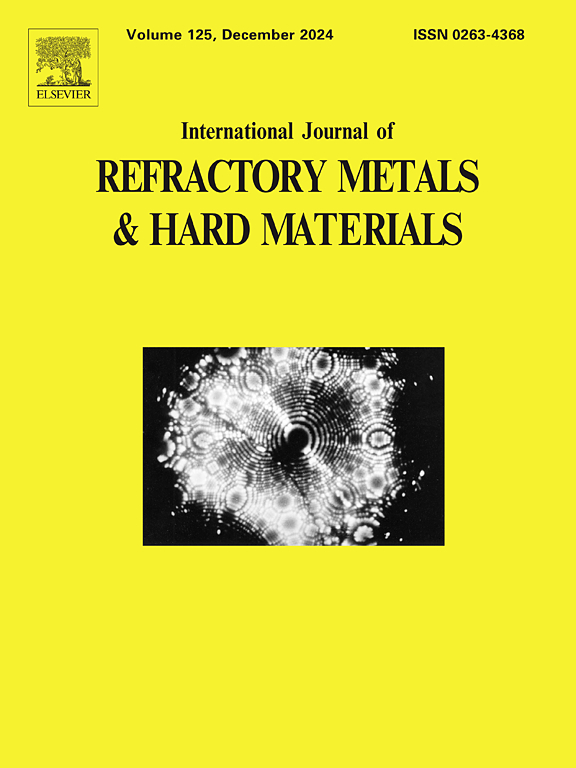Wear mechanisms and crack-healing mechanisms of Ti(C,N)-(W,Ti)C-TiSi2 gradient cermet tool in dry turning of 17-4PH stainless steel
IF 4.2
2区 材料科学
Q2 MATERIALS SCIENCE, MULTIDISCIPLINARY
International Journal of Refractory Metals & Hard Materials
Pub Date : 2025-03-13
DOI:10.1016/j.ijrmhm.2025.107153
引用次数: 0
Abstract
The Ti(C,N)-(W,Ti)C-TiSi2 gradient cermet tool (GT5) fabricated by vacuum hot pressing sintering was used for continuous dry turning of 17-4PH stainless steel at different cutting speeds, and its cutting performance and crack-healing mechanisms were explored in comparison with those of Ti(C,N)-(W,Ti)C-TiSi2 homogeneous cermet tool (TWS20) and Ti(C,N)-(W,Ti)C homogeneous cermet tool (TW15). The results showed that the wear resistance and cutting performance of the GT5 tool were significantly better than those of TWS20 and TW15 tools. At the cutting speed of 150 m/min, the tool life of the GT5 tool was approximately 1.32 times and 2 times that of TWS20 and TW15 tools, respectively. Flank wear, crater wear, chipping and tool material flaking were the main failure modes of the GT5 tool. The main wear mechanisms of the GT5 tool were adhesive wear, oxidative wear and slight abrasive wear, of which oxidative wear was conducive to crack-healing. The contributions of gradient structure to the residual compressive stress, hardness and toughness of its surface layer tool material and the strengthening of tool material by crack-healing mechanisms were responsible for better cutting performance of the GT5 tool. During the dry cutting, the thermal cracks were repaired and filled by the particle TiO2 and glass phase SiO2 generated from the oxidation reaction of TiSi2 and a small amount of WSi2. In addition, the crack tip was passivated by glass phase oxides, which contributed to inhibition of crack propagation and avoidance of tool material flaking. It was confirmed that the crack-healing mechanism could improve the cutting performance and prolong the tool life.
Ti(C,N)-(W,Ti)C- tisi2梯度金属陶瓷刀具干车削17-4PH不锈钢的磨损机理及裂纹修复机理
采用真空热压烧结制备Ti(C,N)-(W,Ti)C- tisi2梯度金属陶瓷刀具(GT5),对17-4PH不锈钢在不同切削速度下进行连续干车加工,并与Ti(C,N)-(W,Ti)C- tisi2均质金属陶瓷刀具(TWS20)和Ti(C,N)-(W,Ti)C- tisi2均质金属陶瓷刀具(TW15)进行对比,探讨其切削性能和裂纹愈合机理。结果表明,GT5刀具的耐磨性和切削性能明显优于TWS20和TW15刀具。在切削速度为150 m/min时,GT5刀具的刀具寿命分别约为TWS20和TW15刀具的1.32倍和2倍。GT5刀具的主要失效形式是刀具侧面磨损、弹坑磨损、切屑和刀具材料剥落。GT5刀具的主要磨损机制为黏着磨损、氧化磨损和轻微磨粒磨损,其中氧化磨损有利于裂纹愈合。梯度结构对其表层刀具材料的残余压应力、硬度和韧性的贡献以及裂纹愈合机制对刀具材料的强化是GT5刀具具有较好切削性能的原因。在干切削过程中,TiSi2与少量WSi2氧化反应生成的颗粒TiO2和玻璃相SiO2对热裂纹进行修复和填充。此外,裂纹尖端被玻璃相氧化物钝化,有助于抑制裂纹扩展和避免刀具材料剥落。实验结果表明,裂纹愈合机制可以改善切削性能,延长刀具寿命。
本文章由计算机程序翻译,如有差异,请以英文原文为准。
求助全文
约1分钟内获得全文
求助全文
来源期刊
CiteScore
7.00
自引率
13.90%
发文量
236
审稿时长
35 days
期刊介绍:
The International Journal of Refractory Metals and Hard Materials (IJRMHM) publishes original research articles concerned with all aspects of refractory metals and hard materials. Refractory metals are defined as metals with melting points higher than 1800 °C. These are tungsten, molybdenum, chromium, tantalum, niobium, hafnium, and rhenium, as well as many compounds and alloys based thereupon. Hard materials that are included in the scope of this journal are defined as materials with hardness values higher than 1000 kg/mm2, primarily intended for applications as manufacturing tools or wear resistant components in mechanical systems. Thus they encompass carbides, nitrides and borides of metals, and related compounds. A special focus of this journal is put on the family of hardmetals, which is also known as cemented tungsten carbide, and cermets which are based on titanium carbide and carbonitrides with or without a metal binder. Ceramics and superhard materials including diamond and cubic boron nitride may also be accepted provided the subject material is presented as hard materials as defined above.

 求助内容:
求助内容: 应助结果提醒方式:
应助结果提醒方式:


